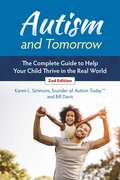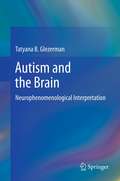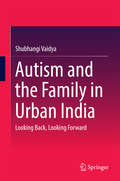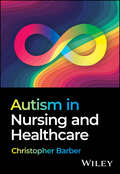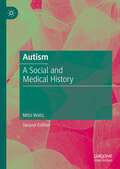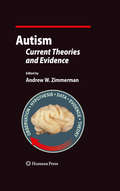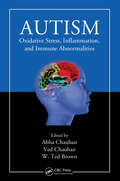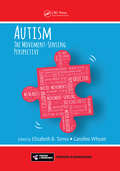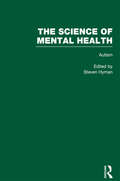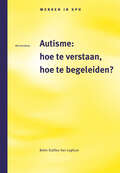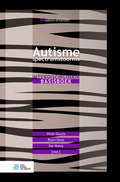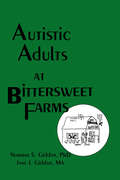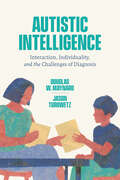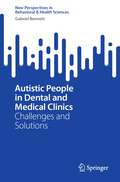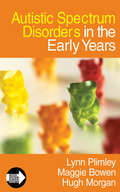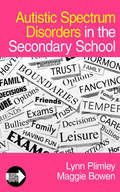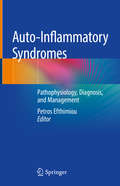- Table View
- List View
Autism and Tomorrow: The Complete Guide to Helping Your Child Thrive in the Real World
by Bill Davis Karen L. SimmonsLooking Ahead to the Future of Autism Study and CareAutism and Tomorrow is a comprehensive resource that addresses many parents’ questions pertaining to their child with autism, such as financial planning, long-term care, employment options, and employer relationships, community resources, education, bullying, puberty, doctor visits, sex, nutrition, fitness, family relationships, and more. Karen L. Simmons, the founder and CEO of Autism Today, and Bill Davis, author of Breaking Autism’s Barriers, offer sound, expert advice derived from their own experiences. Both Simmons and Davis are parents of children with autism; consequently, Autism and Tomorrow is as much an autobiography as it is a reference book. Both authors draw inspiration directly from their own lives and apply their expertise to the general study of the subject. By doing so, Simmons and Davis hope to help other parents, caretakers, relatives, and friends improve both their knowledge of autism, and as a result, the lives of those affected by it.
Autism and the Brain: Neurophenomenological Interpretation
by Tatyana B GlezermanFor years, the typical presentation of autism--the developmental delays, the social and linguistic deficits--has been well known. Despite great variation among children with this condition, certain symptoms are considered hallmarks of the disorder. Less understood is why these symptoms come together to construct autism. And as autism rates continue to rise, this information is ever more vital to accurate diagnosis and treatment. Autism and the Brain offers answers by showing a new neuropsychology of the autistic spectrum, reviewing general brain organization, and relating specific regions and structures to specific clinical symptoms. The author identifies deficiencies in areas of the left-hemisphere associated with the self and identity as central to autism. From this primary damage, the brain further reorganizes to compensate, explaining the diverse behaviors among low- and high-functioning individuals as well as autistic savants. The result is a unique three-dimensional view of brain structure, function, and pathology, with in-depth focus on how the autistic brain: Perceives the world. Understands and uses words. Perceives faces. Understands spatial relations and numbers. Understands feelings and registers emotions. Perceives the self as separate from others. Acts in the world. Challenging readers to re-think their assumptions, Autism and the Brain is breakthrough reading for researchers, clinicians, and graduate students in fields as varied as child and adolescent psychiatry; clinical child, school, and developmental psychology; neuroscience/neurobiology; special education and educational psychology; social work; communication disorders; and public health and policy.
Autism and the Edges of the Known World
by Olga BogdashinaIn this intelligent and incisive book, Olga Bogdashina explores old and new theories of sensory perception and communication in autism. Drawing on linguistics, philosophy, neuroscience, psychology, anthropology and quantum mechanics, she looks at how the nature of the senses inform an individual's view of the world, and how language both reflects and constructs that view. Examining the 'whys' and 'hows' of the senses, and the role of language, Olga Bogdashina challenges common perceptions of what it means to be 'normal' and 'abnormal'. In doing so she shows that autism can help to illuminate our understanding of what it means to be human, and of how we develop faculties that shape our cognition, language, and behaviour. In the final chapter, she explores phenomena often associated with the paranormal - including premonitions, telepathy and déjà vu - and shows that these can largely be explained in natural terms. This book will appeal to anyone with a personal or professional interest in autism, including students and researchers, clinical practitioners, individuals on the autism spectrum and their families, teachers, speech and occupational therapists, and other professionals.
Autism and the Family in Urban India: Looking Back, Looking Forward
by Shubhangi VaidyaThe book explores the lived reality of parenting and caring for children with autism in contemporary urban India. It is based on a qualitative, ethnographic study of families of children with autism as they negotiate the tricky terrain of identifying their child s disability, obtaining a diagnosis, accessing appropriate services and their on-going efforts to come to terms with and make sense of their child s unique subjectivity and mode of being. It examines the gendered dimensions of coping and care-giving and the differential responses of mothers and fathers, siblings and grandparents and the extended family network to this complex and often extremely challenging condition. The book tackles head on the sombre question, What will happen to the child after the parents are gone ? It also critically examines the role of the state, civil society and legal and institutional frameworks in place in India and undertakes a case study of Action for Autism ; a Delhi-based NGO set up by parents of children with autism. This book also draws upon the author s own engagement with her child' s disability and thus lends an authenticity born out of lived experience and in-depth understanding. It is a valuable addition to the literature in the sociology of the family and disability studies.
Autism in Nursing and Healthcare
by Christopher BarberUnderstand the healthcare needs of autistic patients with this essential volume Autism is a condition that directly affects as many as 2 million people in the United Kingdom, a figure which does not include family members and other loved ones. As most nurses, healthcare assistants, and other healthcare professionals will engage with autistic patients or service users at numerous points in their careers, the Health and Care Act 2022 requires healthcare professionals to be given autism training appropriate to their role. There is an urgent need for a publication which directly addresses this new training requirement and fulfills the learning needs of workers across the healthcare sector and beyond. Autism in Nursing and Healthcare offers a solid grounding in the issues relevant to the care and support of autistic people. Viewing autism as a lifelong condition, this book offers chapters covering the full lifespan of the autistic person, with information on the role of nurses in both community and hospital settings. Appropriate for both formal and informal carers, it’s an indispensable resource for anyone with direct or indirect experience of autism. Chapters on welfare benefits, sexuality, and discrimination against autistic people Detailed discussion of the 2009 Autism Act and related strategies Practical intervention strategies throughout Autism in Nursing and Healthcare is ideal for pre-registration nursing students from all four nursing branches, those in post-registration professional development sessions, Nursing Associates and Healthcare Assistants, as well as those who work with autistic people (either as patients or colleagues) looking to better understand autism.
Autism in Translation: An Intercultural Conversation on Autism Spectrum Conditions (Culture, Mind, and Society)
by Clarice Rios Elizabeth FeinAutism is a complex phenomenon that is both individual and social. Showing both robust similarities and intriguing differences across cultural contexts, the autism spectrum raises innumerable questions about self, subjectivity, and society in a globalized world. Yet it is often misrepresented as a problem of broken bodies and disordered brains. So, in 2015, a group of interdisciplinary scholars gathered in Rio de Janeiro, Brazil for an intellectual experiment: a workshop that joined approaches from psychological anthropology to the South American tradition of Collective Health in order to consider autism within social, historical, and political settings. This book is the product of the ongoing conversation emerging from this event. It contains a series of comparative histories of autism policy in Italy, Brazil, and the United States; focuses on issues of voice, narrative, and representation in autism; and examines how the concept of autism shapes both individual lives and broader social and economic systems. Featuring contributions from:Michael BakanBenilton BezerraPamela BlockM. Ariel Cascio Jurandir Freire CostaBárbara Costa AndradaCassandra EvansElizabeth Fein Clara Feldman Roy Richard GrinkerRossano LimaFrancisco OrtegaDawn Prince-HughesClarice Rios Laura Sterponi Thomas S. WeisnerEnrico Valtellina
Autism's False Prophets: Bad Science, Risky Medicine, and the Search for a Cure
by Paul A. OffitA London researcher was the first to assert that the combination measles-mumps-rubella vaccine known as MMR caused autism in children. Following this "discovery," a handful of parents declared that a mercury-containing preservative in several vaccines was responsible for the disease. If mercury caused autism, they reasoned, eliminating it from a child's system should treat the disorder. Consequently, a number of untested alternative therapies arose, and, most tragically, in one such treatment, a doctor injected a five-year-old autistic boy with a chemical in an effort to cleanse him of mercury, which stopped his heart instead. Children with autism have been placed on stringent diets, subjected to high-temperature saunas, bathed in magnetic clay, asked to swallow digestive enzymes and activated charcoal, and injected with various combinations of vitamins, minerals, and acids. Instead of helping, these therapies can hurt those who are most vulnerable, and particularly in the case of autism, they undermine childhood vaccination programs that have saved millions of lives. An overwhelming body of scientific evidence clearly shows that childhood vaccines are safe and does not cause autism. Yet widespread fear of vaccines on the part of parents persists. In this book, Paul A. Offit, a national expert on vaccines, challenges the modern-day false prophets who have so egregiously misled the public and exposes the opportunism of the lawyers, journalists, celebrities, and politicians who support them. Offit recounts the history of autism research and the exploitation of this tragic condition by advocates and zealots. He considers the manipulation of science in the popular media and the courtroom, and he explores why society is susceptible to the bad science and risky therapies put forward by many antivaccination activists.
Autism's False Prophets: Bad Science, Risky Medicine, and the Search for a Cure
by Paul OffitA London researcher was the first to assert that the combination measles-mumps-rubella vaccine known as MMR caused autism in children. Following this "discovery," a handful of parents declared that a mercury-containing preservative in several vaccines was responsible for the disease. If mercury caused autism, they reasoned, eliminating it from a child's system should treat the disorder. Consequently, a number of untested alternative therapies arose, and, most tragically, in one such treatment, a doctor injected a five-year-old autistic boy with a chemical in an effort to cleanse him of mercury, which stopped his heart instead. Children with autism have been placed on stringent diets, subjected to high-temperature saunas, bathed in magnetic clay, asked to swallow digestive enzymes and activated charcoal, and injected with various combinations of vitamins, minerals, and acids. Instead of helping, these therapies can hurt those who are most vulnerable, and particularly in the case of autism, they undermine childhood vaccination programs that have saved millions of lives. An overwhelming body of scientific evidence clearly shows that childhood vaccines are safe and does not cause autism. Yet widespread fear of vaccines on the part of parents persists. In this book, Paul A. Offit, a national expert on vaccines, challenges the modern-day false prophets who have so egregiously misled the public and exposes the opportunism of the lawyers, journalists, celebrities, and politicians who support them. Offit recounts the history of autism research and the exploitation of this tragic condition by advocates and zealots. He considers the manipulation of science in the popular media and the courtroom, and he explores why society is susceptible to the bad science and risky therapies put forward by many antivaccination activists.
Autism: A Social and Medical History
by Mitzi WaltzThis expanded second edition of Mitzi Waltz’s Autism: A Social and Medical History offers an in-depth examination of how the condition was perceived before it became a separate area of investigation, and how autism has been conceptualised and treated since. As well as strengthening the existing text, Waltz has added material on a number of topics that have received increased attention since the first edition, including the rise of the anti-vaccination movement, the shift towards genetic and genomic research, and the progress of the autism self-advocacy movement. The author examines these issues through the perspective of what they mean for autistic people, clinicians and society, and looks at the challenges still faced by autistic people. Waltz also looks at the increased autism diagnosis among girls and women, and how autism has been represented in traditional media and social media. The book includes information from interviews with key researchers, parents of autistic children and people with autism.
Autism: Current Theories and Evidence (Current Clinical Neurology)
by Andrew W. ZimmermanCreative thinking and collaborative scientific research have advanced our understanding of autism, and we are now beginning to synthesize the data into evidence and theories. Autism: Current Theories and Evidence presents current theories about autism and the evidence that supports them. The goal is to show how the scientific method is revealing the biological bases of this spectrum of disorders, thereby leading the way to their treatment and prevention using evidence-based medicine. This book has 20 chapters divided into 6 sections: Molecular and Clinical Genetics; Neurotransmitters and Cell Signaling; Endocrinology, Growth and Metabolism; Immunology, Maternal-Fetal Effects and Neuroinflammation; Neuroanatomy, Imaging and Neural networks; and Environmental Mechanisms and Models. The subjects cover a wide range of current scientific work in the field of autism, with strong and growing evidence to support them, and demonstrate both the breadth and depth of current autism research. The reader is encouraged to consider how theories and the scientific method, in the hands of these and other dedicated researchers, are leading to greater knowledge and continued progress in autism research.
Autism: Oxidative Stress, Inflammation, and Immune Abnormalities
by Ted Brown Ved Chauhan Abha ChauhanIn 2007, the Centers for Disease Control and Prevention issued an autism alarm, estimating that one in 150 children may be affected by autism spectrum disorder. Autism has been treated mainly with technical approaches: principally applied behavior analysis and psychopharmacology. The findings in this book implicate oxidative stress as a common feat
Autism: The Movement Sensing Perspective (Foundations and Innovations in Neurobiology)
by Elizabeth B. Torres Caroline WhyattAutism: The Movement Sensing Perspective is the result of a collaborative effort by parents, therapists, clinicians, and researchers from all disciplines in science including physics, engineering, and applied mathematics. This book poses questions regarding the current conceptualization and approach to the study of autism, providing an alternative unifying data-driven framework grounded in physiological factors. This book reaches beyond subjective descriptions of autistic phenomena and embraces a new era of objective measurements, analyses, and statistical inferences. The authors harness activities from the nervous systems across the brain and body (often in tandem), and introduce a platform for the comprehensive personalized phenotyping of individuals with autism. The impact of this approach is discussed to advance the development of tailored treatments options, enhance the ability to longitudinally track symptomatology, and to fundamentally empower affected individuals and their families. This book encompasses a new era for autism research and treatments, and our continuous effort to collectively empower and embrace the autistic community.
Autism: The Science of Mental Health (The Science of Mental Health #2)
by Steven HymanThe Science of Mental Health: Volume 2: Autism by Steven Hyman
Autisme: hoe te verstaan, hoe te begeleiden?
by Mathieu Heemelaar A.J. Ravelli M. Magnee M.J. van Deutekom Marijke van Bommel A.F. BobbinkWerken in SPH Autisme: hoe te verstaan, hoe te begeleiden ?
Autismespectrumstoornis: Interdisciplinair basisboek
by Hilde Geurts Bram Sizoo Ilse NoensUniek voor het Nederlands taalgebied: een standaardwerk autismespectrumstoornis [ASS]. #65533; Het hele spectrum in beeld. #65533; Aandacht voor de verschillen tussen kinderen, tieners en volwassenen met ASS. #65533; De benadering is interdisciplinair: vanuit de psychologie, de ortho)pedagogiek en de psychiatrie. #65533; Een bundeling van Nederlandse en Vlaamse expertise. #65533; Niet alleen wetenschappers aan het woord maar ook ervaringsdeskundigen. Het boek heeft alles om: #65533; h#65533;t leerboek te worden voor ASS-hulpverleners in opleiding; #65533; h#65533;t naslagwerk te worden voor experts uit de psychologie, (ortho)pedagogiek en psychiatrie. Dit boek is hard nodig. Moderne statistieken stellen het v#65533;orkomen van ASS -gemiddeld- op 1% van de bevolking; Nederland telt dan 160. 000 en Vlaanderen 60. 000 mensen met ASS.
Autistic Adults at Bittersweet Farms
by Norman Giddan Jane J GiddanAutistic Adults at Bittersweet Farms is a touching view of an inspirational residential care program for autistic adolescents and adults. This compelling book focuses on adult autism treated through the concepts used at Bittersweet Farms, an 80-acre farm in northwest Ohio. Through historical rationale for a therapeutic community, a comparison between the Bittersweet Farms model and treatment settings in the United Kingdom, specific treatments and training programs at Bittersweet Farms, and staff, parent, and resident viewpoints, the innovative program--based on the premise that adults with autism continue to need special care and training throughout their lives--is brought to life. Divided into three sections, Autistic Adults at Bittersweet Farms returns repeatedly to the concept behind the program--molding autistic adults into contributing members of society in their own ways. Section One includes a potpourri of information, giving a glimpse of the range of models available for treatment and what makes each program a success. Taking a closer look at program considerations within various community settings, the second section examines behavior modification techniques in training autistic children and educating their parents. As politics play an important role in developing an innovative care program like Bittersweet Farms, the final section delves into regulations and funding for different types of residential care programs. Ending on a very human and optimistic note, section three closes with three personal accounts of life and work at Bittersweet Farms from a staff member, a resident, and a parent, with each praising a different aspect of the total person care environment of Bittersweet Farms. Occupational and physical therapists, policymakers, educators, and parents of autistic children will be encouraged from reading this outstanding book.
Autistic Community and the Neurodiversity Movement: Stories from the Frontline
by Steven K. KappThis open access book marks the first historical overview of the autism rights branch of the neurodiversity movement, describing the activities and rationales of key leaders in their own words since it organized into a unique community in 1992. Sandwiched by editorial chapters that include critical analysis, the book contains 19 chapters by 21 authors about the forming of the autistic community and neurodiversity movement, progress in their influence on the broader autism community and field, and their possible threshold of the advocacy establishment. The actions covered are legendary in the autistic community, including manifestos such as “Don’t Mourn for Us”, mailing lists, websites or webpages, conferences, issue campaigns, academic project and journal, a book, and advisory roles. These actions have shifted the landscape toward viewing autism in social terms of human rights and identity to accept, rather than as a medical collection of deficits and symptoms to cure.
Autistic Intelligence: Interaction, Individuality, and the Challenges of Diagnosis
by Douglas W. Maynard Jason TurowetzAn examination of diagnostic processes that questions how we can better understand autism as a category, recognizing its intelligence and uncommon sense. As autism has become a widely prevalent diagnosis, we have grown increasingly desperate to understand it. Whether by placing unfounded blame on vaccines or seeking a genetic cause, Americans have struggled to understand what autism is and where it comes from. Amid these efforts, however, a key aspect of autism has been largely overlooked: the diagnostic process itself. The authors of Autistic Intelligence ask us to question the norms we use to measure autistic behavior, to probe how autistic behavior can be considered sensible rather than disordered, and to explore how we can better appreciate the individuality of those who receive the diagnosis. Drawing on hundreds of hours of video recordings and ethnographic observations at a clinic where professionals evaluate children for autism, the authors’ analysis of interactions among clinicians, parents, and children demystifies the categories, tools, and practices involved in the diagnostic process. Autistic Intelligence shows that autism is not a stable category, but the outcome of complex interacting processes involving professionals, children, families, and facets of the social and clinical environments they inhabit. The authors suggest that diagnosis, in addition to carefully classifying children, also can highlight or include unique contributions those with autism make to the world around us.
Autistic Intelligence: Interaction, Individuality, and the Challenges of Diagnosis
by Douglas W. Maynard Jason TurowetzAn examination of diagnostic processes that questions how we can better understand autism as a category, recognizing its intelligence and uncommon sense. As autism has become a widely prevalent diagnosis, we have grown increasingly desperate to understand it. Whether by placing unfounded blame on vaccines or seeking a genetic cause, Americans have struggled to understand what autism is and where it comes from. Amid these efforts, however, a key aspect of autism has been largely overlooked: the diagnostic process itself. The authors of Autistic Intelligence ask us to question the norms we use to measure autistic behavior, to probe how autistic behavior can be considered sensible rather than disordered, and to explore how we can better appreciate the individuality of those who receive the diagnosis. Drawing on hundreds of hours of video recordings and ethnographic observations at a clinic where professionals evaluate children for autism, the authors’ analysis of interactions among clinicians, parents, and children demystifies the categories, tools, and practices involved in the diagnostic process. Autistic Intelligence shows that autism is not a stable category, but the outcome of complex interacting processes involving professionals, children, families, and facets of the social and clinical environments they inhabit. The authors suggest that diagnosis, in addition to carefully classifying children, also can highlight or include unique contributions those with autism make to the world around us.
Autistic Intelligence: Interaction, Individuality, and the Challenges of Diagnosis
by Douglas W. Maynard Jason TurowetzAn examination of diagnostic processes that questions how we can better understand autism as a category, recognizing its intelligence and uncommon sense. As autism has become a widely prevalent diagnosis, we have grown increasingly desperate to understand it. Whether by placing unfounded blame on vaccines or seeking a genetic cause, Americans have struggled to understand what autism is and where it comes from. Amid these efforts, however, a key aspect of autism has been largely overlooked: the diagnostic process itself. The authors of Autistic Intelligence ask us to question the norms we use to measure autistic behavior, to probe how autistic behavior can be considered sensible rather than disordered, and to explore how we can better appreciate the individuality of those who receive the diagnosis. Drawing on hundreds of hours of video recordings and ethnographic observations at a clinic where professionals evaluate children for autism, the authors’ analysis of interactions among clinicians, parents, and children demystifies the categories, tools, and practices involved in the diagnostic process. Autistic Intelligence shows that autism is not a stable category, but the outcome of complex interacting processes involving professionals, children, families, and facets of the social and clinical environments they inhabit. The authors suggest that diagnosis, in addition to carefully classifying children, also can highlight or include unique contributions those with autism make to the world around us.
Autistic People in Dental and Medical Clinics: Challenges and Solutions (New Perspectives in Behavioral & Health Sciences)
by Gabriel BennettWith 1 in 44 people now being diagnosed as autistic, there is a view that clinical environments should be “autistic friendly”. However, despite this expectation, medical and dental students are rarely taught how they can make their future clinical workplaces comfortable for autistic patients. Similarly, allied health professional, such as occupational therapists and psychologists, are also not taught this information. Due to this lack of knowledge, each day countless autistics and their families are exposed to potentially stressful clinical situations that can jeopardise the delivery of effective treatment. To help mitigate this situation, this book will give university students as well as established healthcare professionals an understanding of how they can assist autistic patients in clinical settings.This book is more than just providing strategies that aspiring and established healthcare professionals can use to make their clinical workplaces more accommodating for autistics and their families. It will also present a synopsis of the literature about the challenges and experiences that autistic patients have had in dental and medical settings. Such information can provide the reader with a greater understanding about what it is like to be autistic and receive medical and/or dental treatment. This synopsis will also illustrate the current gaps in our knowledge about this topic.
Autistic Spectrum Disorders in Children
by Vidya Bhushan GuptaImpeccably researched and written by a nationally known team of specialists from neurodevelopmental pediatrics, psychology, epidemiology, education, occupational therapy, and speech therapy backgrounds, "Autistic Spectrum Disorders in Children" presents a multidisciplinary profile of autism and pervasive developmental disorders in children. Tracing
Autistic Spectrum Disorders in the Early Years (Autistic Spectrum Disorder Support Kit)
by Ms Lynn Plimley Mr Hugh Morgan Maggie Bowen'An extremely helpful, compact guide for anyone working in early years education... provides clear information for all professionals who work with children from birth to five with autistic spectrum disorders... A short, accessible and reader-friendly book that addresses the key issues' - Nursery Education Looking at the early years of a child's life, this book provides information on the services that are available for those from birth to five years, and addresses issues related to identification, assessment, teaching and learning and family support. It is illustrated with case studies provided by parents and practitioners. The following areas are discussed: o the Code of Practice for SEN & the SEN and Disability Discrimination Act o identification and assessment o good practice examples of multi-agency collaboration and provision o partnership with parents o social skills and behaviour o alternative intervention and home-based programmes o the transition from pre-school to school. Professionals in Health, Social Services and Education, pre-school playgroups, nursery staff, parents and carers will all find this book useful. Conference Information The Good Autism Practice (GAP) conference is based on the successful foundations of the Good Autism Practice (GAP) journal, which provides a platform for acknowledging and sharing good practice in autism.
Autistic Spectrum Disorders in the Secondary School (Autistic Spectrum Disorder Support Kit)
by Ms Lynn Plimley Maggie Bowen'I liked the way it dealt with the difficult issues such as mental health, sexuality and future employment in a clear and direct way, providing well thought out, practical responses.' 'Easy to read yet informative.' 'Very accessible in an area of SEN that is now a key area of concern.' ' Captivating, good presentation with the case studies, reflective oasis and points to remember.' 'Very useful for Sencos and teachers.' - Judging Panel for NASEN/TES Book Award 'There can be no doubt that the action suggested by the authors to improve outcomes for pupils with ASD, would benefit the inclusion of all pupils' - Special Needs Information Press 'The book gives a clear insight into some of the issues which are important from the perspective of the pupil, the challenges they face and the behaviours that can result. It openly addresses the impact of these behaviours on a school and offers clear guidance and strategies. The options given are realistic, practical and achievable and the Reflective Oasis sections offer an ideal starting point for self-evaluation and staff training' - Mike Ridout, Head of Access and Inclusion Service, Bridgend LEA 'All those involved in education at secondary level including senior managers and governors will find this concise book informative in helping them to understand the needs of their pupils with ASD' - Ian Attfield, Advisory Teacher ASD, Birmingham Specialist Support Service 'The book not only gives sound advice, it helps the reader to find a wider range of sources of support and information... a useful, practical guide that makes the organisation of inclusive education achievable' - Special 'The book does have a number of useful strategies and tips, but it provides more than just a list of practical points. Support staff are encouraged to reflect upon their own practice and that of their school... The book is well worth buying and should appeal both to support workers and their managers' - Support For Learning 'The book fills a niche by distilling and providing information to busy teachers... an important little book that is quite readable and may be very useful to its intended audience' - American Psychological Association When a young person with autistic spectrum disorders enters secondary school, there are lots of new factors to consider. This books looks at: " making good transitions from primary school " how to provide helpful INSET for colleagues (including teachers, senior managers, support staff and lunchtime supervisers) " using a special interest as a tool for learning " record-keeping, IEPs and sharing information across the school " subject disapplication and formal examinations " social strategies to employ in a large high school " useful tips for staff - what to do and what not to do " work experience, careers and self-advocacy The importance of working closely with parents is also covered, as is dealing with challenging behaviour. '...the book not only gives sound advice, it helps the reader to find a wider range of sources of support and information...The authors have not sought to minimise the difficulties or to pretend that schools and individuals will not have to change or adapt, nor have they avoided difficult questions. What they have one is to write a useful, practical guide that makes the organisation of inclusive education achievable' - Resource File
Auto-Inflammatory Syndromes: Pathophysiology, Diagnosis, and Management
by Petros EfthimiouThis book provides an overview of auto-inflammatory syndromes, covering the underlying immune mechanisms that lead to their development, specific disease presentations, and clinical treatment guidelines. The book is divided into two sections, adult and pediatric, with chapters focusing on individuals diseases such as systemic arthritis, hyper-IgD, pap syndrome, idiopathic recurrent pericarditis, and familial Mediterranean fever. Chapters incorporate the most recent advances in disease pathophysiology and examine the underlying inductive and effector mechanisms and therapies that relate to each auto-inflammatory disorder at the genetic, molecular, cellular, and epidemiologic levels. The book also discusses the research behind auto-inflammatory disorders to offer detailed clinical guidelines regarding diagnostic techniques, treatment plans, and advice on how to best transition pediatric patients into adult treatment. This is an invaluable reference on auto-inflammatory syndromes for clinicians and researchers in pediatric and adult rheumatology and immunology.
